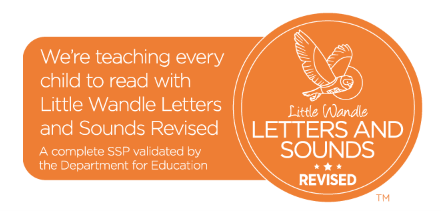Little Wandle, Letters and Sounds, Revised
Our Phonics lead is: Mrs Hibbert
‘The world belongs to those who read.’ - Rick Holland
At Sharow Church of England Primary School we believe that for all our children to become fluent readers and writers, phonics must be taught through a systematic and structured phonics programme.

We use the Little Wandle Letters and Sounds Revised to plan and provide daily engaging phonics lessons. In phonics, we teach children that the letters of the alphabet represent a different sound, that these can be used in a variety of combinations and are put together to make words. The children learn to recognise all of the different sounds and combinations that they might see when they are reading or writing. Our phonics teaching starts in Nursery and follows a very specific sequence that allows our children to build on their previous phonic knowledge and master specific phonic strategies as they move through school. As a result, all our children are able to tackle any unfamiliar words that they might discover. At Sharow, we also model these strategies in shared reading and writing both inside and outside of the phonics lesson and across the curriculum. We have a strong focus on the development of language skills for our children because we know that speaking and listening are crucial skills for reading and writing in all subjects.
Long Term Plan and Overview and Progression of skills
This programme overview shows the progression of GPCs and tricky words that we teach term-by-term. The progression has been organised so that children are taught from the simple to more complex GPCs, as well as considering the frequency of their occurrence in the most commonly encountered words. All the graphemes taught are practised in words, sentences, and later, in fully decodable books. Children review and revise GPCs and words, daily, weekly and across terms and years, in order to move this knowledge into their long term memory.
Children need to learn to read as quickly as reasonably possible, so they can move from learning to read, to reading to learn, giving them access to the treasure house of reading. Our expectations of progression are aspirational yet achievable if schools maintain pace, practice and participation by all children. Children who are not keeping-up with their peers should be given additional practice immediately through keep-up sessions
Please click the link for the programme progression overview of Reception and Year 1.
Parents
If you are a parent and would like more information about how to support your child with phonics at home, please follow this link for parents. Here you will find the Reception and Year 1 overview as well as videos of the sound pronunciations, letter formation sheets and other helpful resources.
Click on the icon below to access the Little Wandle page.
Phonics Screen Check
What is the Y1 Phonics Screening Check?
The Phonics Screening Check is meant to show how well your child can use the phonics skills they’ve learned up to the end of Year 1 and to identify students who need extra phonics help. The Department for Education defines the checks as “short, light-touch assessments” that take about four to nine minutes to complete.
How do children complete the Phonics Screening Check?
The checks consist of 40 words and non-words that your child will be asked to read one-on-one with a teacher. Non-words (or nonsense words, or pseudo words) are a collection of letters that will follow phonics rules your child has been taught, but don’t mean anything – your child will need to read these with the correct sounds to show that they understand the phonics rules behind them.
The 40 words and non-words are divided into two sections – one with simple word structures of three or four letters, and one with more complex word structures of five or six letters. The teacher administering the check with your child will give them a few practice words to read first – including some non-words – so they understand more about what is required of them. Each of the non-words is presented with a picture of a monster / alien, as if the word were their name (and so your child doesn’t think the word is a mistake because it doesn’t make sense!).
When does the Y1 Phonics screening check take place?
Schools will administer the Year 1 Phonics Screening Check in June.
Does my child have to take it?
Yes – all students in Year 1 in England must take the Screening Check.
What will my child’s score mean?
Your child will be scored against a national standard, and the main result will be whether they fall below, within or above this standard.
In 2013 – present the “pass threshold” has been 32, which means children had to read at least 32 words out of 40 correctly. The threshold mark is communicated to schools at the end of June, after the test has been taken, so that teachers can mark the Check.
You will be told how your child did, but schools’ results will not be published. If your child’s score falls below the standard, they will be given extra phonics help and can re-take the Phonics Screening Check in Year 2.

